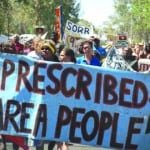A MAJOR investment program in Aboriginal housing in the NT is being used as a weapon to further break up community control, push people out of remote areas and entrench the NT intervention.
The $647 million Strategic Indigenous Housing and Infrastructure Program (SIHIP) is a joint venture between the Federal and NT governments.
Under SIHIP, communities are being denied new housing until they sign control of township land over to the government for between 40 and 90 years. 
And despite overcrowding being a serious problem in virtually all 73 communities “prescribed” under the NT intervention, only 16 have been offered any new housing, along with the town camps in major population centres like Alice Springs and Darwin.
Even many larger communities of more than 500 people are excluded, such as Papunya and Ali Curung, with on average 12 people living to a house.
SIHIP is a further step in the government strategy of assimilation and “population concentration”.
The Northern Territory Emergency Response task force, in their June report, recommended precisely such a restriction of resource provision to communities deemed “economically viable” in order to force Aboriginal people off remote communities on their traditional lands.
Aboriginal control
Community control of township land was won through decades of struggle for Land Rights. It signaled a break with the days when Aboriginal lives were controlled by paternalistic welfare boards and mission managers. It ensures that local people have input into what developments take place on their land and play a central role in service delivery.
As a result of the NT intervention, compulsory five-year leases have already been imposed by the federal government over “prescribed” communities.
Even the government’s official review into the intervention found that the subsequent denial of community control has caused enormous damage and left hundreds of millions of dollars wasted on ineffective projects.
The five-year leases have allowed control over current housing arrangements in some areas to be taken away from community-based committees and given to the “mainstream” NT Government public housing agency. This means higher rents, more restrictive tenancy conditions and easier eviction. SIHIP would write these intervention powers into stone.
Contracts for construction under SIHIP have already been signed with multi-national construction and infrastructure consortiums.
For example, Parsons-Brinkerhoff, who have made millions from reconstruction contracts in Iraq, are now following the troops into NT Aboriginal communities. They have a guaranteed place on the SIHIP operational steering committee.
Many of the communities being pressured to sign leases have said they will not be held to ransom for basic entitlements.
Aboriginal resistance
When Aboriginal Affairs Minster Jenny Macklin visited the Central Australian community of Yuendumu, she was presented with a petition signed by 236 residents denouncing the intervention and stating, “We want the Government to stop blackmailing us. We want houses, but we will not sign any leases over our land, because we want to keep control of our country, our houses, and our property”.
David Ross, Director of the Central Land Council has said, “Aboriginal people are being delivered ultimatums—sign a lease with Canberra before Christmas or forget about any further funding… of course people are resisting.”
It is becoming increasingly clear that, along with the $1 billion already spent on the Intervention, much of the money allocated to “close the gap” will be used to further disempower and dispossess Aboriginal people unless there is a serious fight-back.
On November 7, the Prescribed Area People’s Alliance, whose meetings have been attended by over 130 people, condemned the SIHIP leases and stated:
“We call on other communities to take action, in their communities. We call for rallies here in Alice Springs and around the country to mark Human Rights Day on December 13, 60 years since the UN human rights charter was signed. We call for everyone who supports Aboriginal rights to converge on Canberra for the opening of Parliament in 2009”.
By Paddy Gibson





